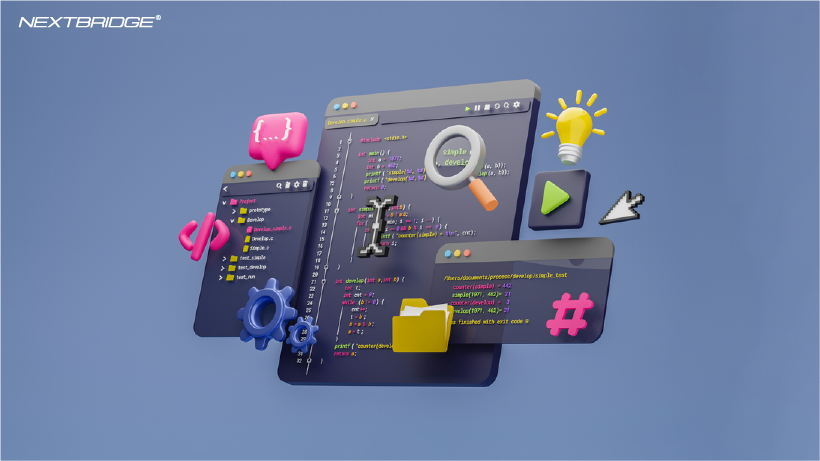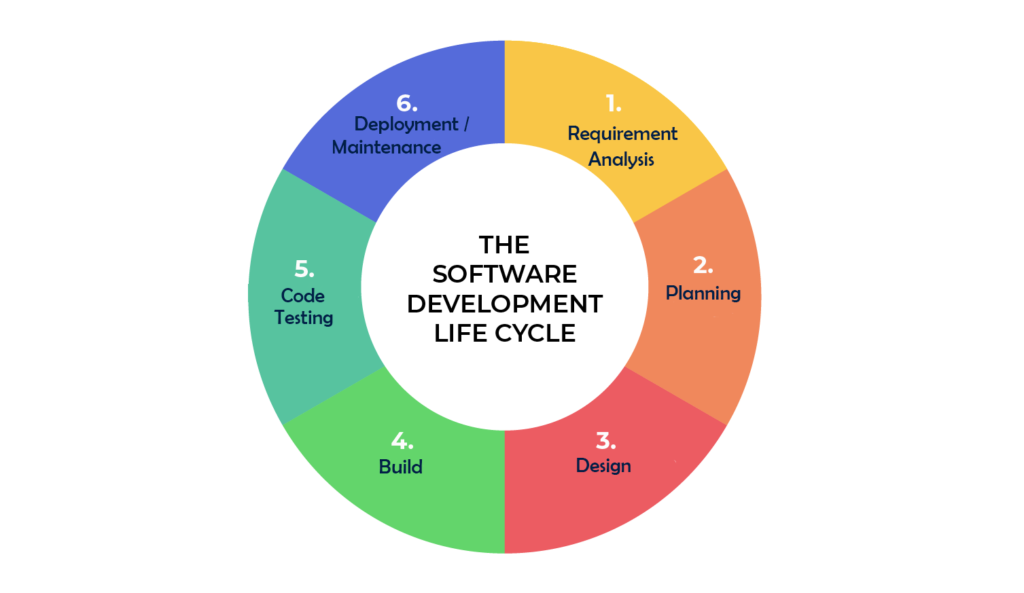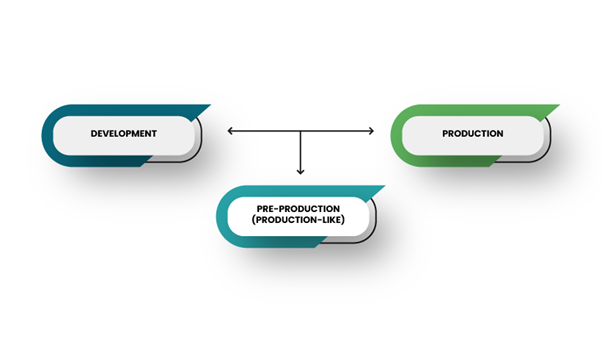Blogs
6 Stages of SDLC vs. 3-Stages of SDLC: What’s Better & What’s Not!

 By Nextbridge Editorial Team
By Nextbridge Editorial Team
4 minutes read
When talking about stages of SDLC, since the 1990s, most organizations have adopted a six-stage software development life cycle (SDLC) to guarantee quality and detect as many issues as possible before release. But today, we have begun a new debate on how to reduce your six-stages development lifecycle to three stages. So, let’s talk about whether this change has any value or if we should stick to the old six-stages life cycle.
Here Are Six Stages of SDLC
The Software Development Life Cycle is a process that is followed to complete relevant tasks in a short period; from coding, testing to production. It is also known as the system development lifecycle or application development lifecycle.

Most SDLCs have 6 phases, but since Rishi Yadav, co-founder of Roost.ai has proposed 3-phases SDLC, the internet is divided.
Were you able to read his article? We have read it and would like to provide our three cents.
Disclaimer: Read it thoroughly and don't assume anything beforehand!
Following are the SDLC phases that are currently being followed:
- Planning: The planning stage is also known as the feasibility stage. In this part of the SDLC, you actually create a plan while keeping all the services and technologies in mind. During this phase, you determine the scope of work, how it will be executed, and the precise objectives.
- Analysis: If you're planning to introduce a service or product, you'll need to gather all the necessary information and requirements that must be met at the outset. In addition, the prototype ideas are analyzed. Among other stages of SDLC, it is the step where you need to choose hardware, software tools, or technologies.
- Design: This design stage of SDLC is at the core of the whole process. The first step is to evaluate the UI/UX design and database requirements. After the basic flowchart or mockup for the app or website is outlined on paper or through designing software, you move on to the development (implementation) stage.
- Development: Now it is time to show the magic, which means to develop the application, keeping all these SDLC phases in mind. The developers write code and make it happen. Furthermore, compilers and interpreters are used to fix bugs.
- Testing & Integration: The end-user experience is vital, and software life cycle phases don't end at coding, but the real work begins there. To analyze the functionality of the code, it is thoroughly tested and integrated with other source codes.
- Maintenance: As soon as the software goes live, the developers are in maintenance mode, ready to make changes. This is when the remaining bugs are fixed.
Related Category: We offer
software maintenance and support services!
Key Phases: Development and Production
Rishi believes that in stages of SDLC, development and production are the two major stages that require more attention than the middle 3 stages (testing, integration, and staging), which are less important.

Basically, what he did is skip the middle three stages of SDLC, and instead, he carried forward the pre-production (production-like) phase that combined all the tasks completed in the middle three stages without a hitch.
In reality, development and production are the most important stages of SDLC. Application development is where the application is born. Production is where the application lives. Focus on the beginning and the end of the SDLC, and help applications move as quickly and efficiently as possible between them.
A six-stage software development life cycle undervalues the testing, integration, and staging phases of an application's development. Moreover, this type of lifecycle is more error-prone and slower than more modern, cloud-native approaches - exactly what you want to avoid.
The idea of reducing development and production distance in stages of SDLC is to increase development velocity while also reducing change failure rates. A three-stage software development life cycle accomplishes this. Furthermore, it gives developers more control over testing and hardening their services, giving them more confidence to ship.
Pre-Production (Production-Like) Stage: Rishi’s Suggestion
During this stage, the developer must be able to test the code on his own. Yes, the goal is to let him analyze the whole functionality of the application and work through issues just like a real genius.
Hence, Rishi added this to the software life cycle phases and made developers' tasks more feasible and accurate. With this system, the developer can check codes for errors, configuration issues, integration limitations, and conduct load speed tests.
Change Validation Tool: It helps a person determine if all the code lines fall under the exact working environment and whether the expected dependencies are met.
Review of the Situation
SDLC phases can do wonders in many cases, no matter how many there are.
We believe, when the long projects have to be handled, the 6-stage SDLC will make a real difference because the heavy software contains detailed codes and they must be checked and analyzed in chunks.
If you've built software that's catering to a large number of users' information or a large number of products or services, then you'll have to design, integrate, and even test it. Therefore, in that case, a 6-stage SDLC would be a win-win situation.
However, if a project is small or you know it will only take a few days or weeks, then you can choose a 3-stage software life cycle. In this way, a developer can do coding, testing, or integration on his own.
Additionally, it is dependent on the work environment of the company which has taken all the responsibilities related to software and app development, such as if they feel that a 6-stage software life cycle suits them or if they find that three SDLC phases deliver the desired results.
Final Thoughts
In almost all software development and design companies, the Software Development Lifecycle (SDLC) is implemented to make every task an easy-to-do chunk. It's just a matter of deciding what works best for you and getting ready to make magic.
 Back to all articles
Back to all articles


 Most SDLCs have 6 phases, but since Rishi Yadav, co-founder of Roost.ai has proposed 3-phases SDLC, the internet is divided.
Were you able to read his article? We have read it and would like to provide our three cents.
Disclaimer: Read it thoroughly and don't assume anything beforehand!
Following are the SDLC phases that are currently being followed:
Most SDLCs have 6 phases, but since Rishi Yadav, co-founder of Roost.ai has proposed 3-phases SDLC, the internet is divided.
Were you able to read his article? We have read it and would like to provide our three cents.
Disclaimer: Read it thoroughly and don't assume anything beforehand!
Following are the SDLC phases that are currently being followed:
 Basically, what he did is skip the middle three stages of SDLC, and instead, he carried forward the pre-production (production-like) phase that combined all the tasks completed in the middle three stages without a hitch.
In reality, development and production are the most important stages of SDLC. Application development is where the application is born. Production is where the application lives. Focus on the beginning and the end of the SDLC, and help applications move as quickly and efficiently as possible between them.
A six-stage software development life cycle undervalues the testing, integration, and staging phases of an application's development. Moreover, this type of lifecycle is more error-prone and slower than more modern, cloud-native approaches - exactly what you want to avoid.
The idea of reducing development and production distance in stages of SDLC is to increase development velocity while also reducing change failure rates. A three-stage software development life cycle accomplishes this. Furthermore, it gives developers more control over testing and hardening their services, giving them more confidence to ship.
Basically, what he did is skip the middle three stages of SDLC, and instead, he carried forward the pre-production (production-like) phase that combined all the tasks completed in the middle three stages without a hitch.
In reality, development and production are the most important stages of SDLC. Application development is where the application is born. Production is where the application lives. Focus on the beginning and the end of the SDLC, and help applications move as quickly and efficiently as possible between them.
A six-stage software development life cycle undervalues the testing, integration, and staging phases of an application's development. Moreover, this type of lifecycle is more error-prone and slower than more modern, cloud-native approaches - exactly what you want to avoid.
The idea of reducing development and production distance in stages of SDLC is to increase development velocity while also reducing change failure rates. A three-stage software development life cycle accomplishes this. Furthermore, it gives developers more control over testing and hardening their services, giving them more confidence to ship.




